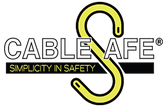Contributor: CableSafe®

One of the most dangerous scenarios at work is when someone drops something while working at a height or an object is knocked off an edge unexpectedly, which can result in terrible injuries or fatalities to employees. Employers must have a safe work procedure in place for employees working at heights, as well as give proper training to all employees involved. Inspection of equipment and working platforms is required on a regular basis to ensure the safety of individuals working at height as well as those present below the working areas.
FAQs
How to avoid falling objects when working at heights?
- Avoiding falling objects while working at heights is a critical step that necessitates specialized employee training to assist employees in adhering to safety regulations.
- For lifting, secure all materials in closed buckets or bags and tie them to an anchoring point at the top.
- Before climbing any structure, always secure all tools and light weight devices with a tool belt or harness using clips, lanyards, or tethering aids.
- Install a safety net below the workers at height or barricade the area for preventing falling object injuries at site.
How can you prevent falling objects at work?
- Secure all tools by using tool lanyards/belts to prevent them from falling.
- Preventing falling object injuries on the jobsite can be accomplished by keeping excess material, other than material explicitly necessary for work in progress, at least 3 feet away from a leading edge.
- Objects should not be hung from guardrails.
- Secure all materials before working on elevated surfaces to help avoiding falling objects accidentally.
- Toe boards must be in place and should be inspected on a regular basis.
How can you prevent materials/objects at heights from falling?
- Use a double-boarded platform with a polythene sheet in between the boards when working in public areas to keep small items like nails and bolts from falling.
- Close-boarded platforms should be used so that materials or things do not fall and injure anyone or anything below.
- To prevent items from falling, scaffolding and tower scaffolds should be equipped with brick guards, netting, or other adequate protection.
- Use mesh or netting underneath the equipment when working on a mobile elevated platform to keep things from falling.
How to prevent falling objects in the workplace?
- Install a safety net at workplace to protect employees from falling objects; however, they are not designed to catch heavy objects and should not be used in place of a harness system.
- Identify high-risk sites and clearly mark them to remind personnel to wear PPE in the area to avoid being injured by falling objects.
- Install a harness system for the tools to improve the safety from falling objects at workplace. These harnesses can have extendable cords connected to them to make it easier to move about while utilizing tools.
- Only bring required tools at work site to do the task.
- Always keep edges clear and place extra tools or equipment in designated areas only.